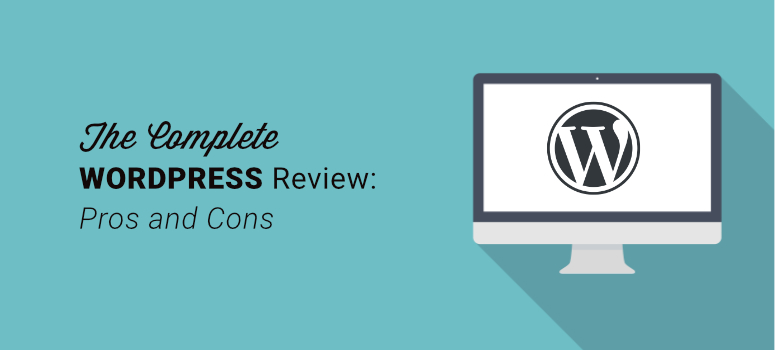
Are you wondering if you should make your website with WordPress?
You might have heard a lot about WordPress; it is the most popular content management system after all. But, you may still be wondering if it’s the best choice for you to make a website.
For starters, WordPress is very easy to use, and even with no experience, you can quickly set up your site. On top of this, WordPress is open-sourced. This means plenty of WordPress experts have created tools and plugins to help with different things.
As a result, you can access many affordable, ready-made solutions to help you improve functionality.
For example, IsItWP is a WordPress website. This has helped us test almost every aspect of this CMS. We have used it to create eCommerce stores, blogs, business websites, portfolio platforms, and more.
In this WordPress review, we’ll go over what WordPress is. We share the pros and cons of using WordPress to build a website, the cost of WordPress, and more from our first-hand experience.
Let’s get started.
What Is WordPress?
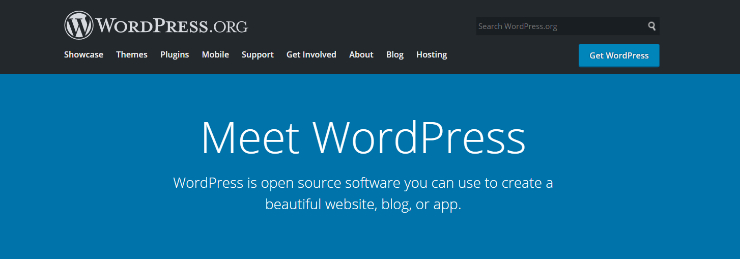
WordPress is a content management system (CMS) that allows you to easily create and manage important features of your website without needing to know anything about coding or programming. In simpler terms, WordPress is a website builder that makes it easy for beginners to launch a website.
WordPress is free and open-source software, which means it’s free for anyone to download and you can use the software for any purpose you want. Does this mean it’s completely free to build a website with WordPress? Well, not exactly, to make a WordPress website you still need to register a domain name and web hosting. But, we’ll get to that later.
It’s also important to know that there’s a difference between WordPress.org and WordPress.com. While WordPress.org is self-hosted software, WordPress.com is a freemium website hosting service. With WordPress.org you have complete control and ownership of your site. Plus, you get access to all WordPress features right out of the box. But with WordPress.com, there are a lot of limitations and restrictions.
For more details, check out our article on WordPress.com vs. WordPress.org – is one really better than the other?
In this article, we’ll be reviewing WordPress.org, which we recommend you choose over WordPress.com to build a website. So, anytime we mention WordPress going forward, we’re referring to WordPress.org.
Now that you know what WordPress is, let’s take a look at how popular it is.
How Popular is WordPress?
WordPress is the most popular CMS in the world. In fact, it powers 43.1% of the entire internet. That percentage is leaps and bounds ahead of other content management systems like Joomla, Drupal, Shopify, and Squarespace.
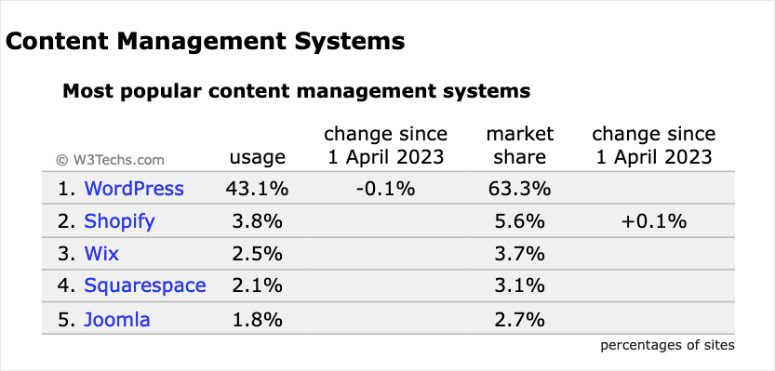
That statistic alone is enough to show you how many people use and trust WordPress to build their websites.
Not convinced about the popularity of WordPress? Check out these other interesting WordPress statistics:
- 14.7% of the top 100 Websites are powered by WordPress.
- WordPress’ share of the global content management market is 43.1%.
- As of 2023, around 810 million people choose WordPress to power their website or blog.
Typically, there’s safety in numbers. If so many people are using WordPress, it’s a safe bet that WordPress is a good choice for you too.
If you have seen a site somewhere and are wondering if it is built on this CMS, you can use our Free WordPress Checker to find out.
What Types of Websites Can You Create with WordPress?
WordPress started out as a simple blogging platform back in 2003. But, while WordPress may be best known for blogs, it has since evolved. The types of websites you can create with WordPress are endless.
WordPress offers thousands of free and paid themes and plugins that enable you to customize your website for your exact needs completely. This allows a wide range of business types to use WordPress to build their websites. For instance, the popular restaurant group Momofuku uses WordPress for its website.

As you can see, WordPress isn’t just for creating simple blogs. In fact, check out all the different types of websites you can create with WordPress:
- Blog or personal website
- Business website
- eCommerce site
- Nonprofit website
- Online communities
- Portfolio websites
- Job board
- And much more
So, WordPress is powerful enough to create any type of website you desire.
What are the Pros and Cons of WordPress?
As with any website builder, there are pros and cons that you should look closely at to help determine whether it’s right for you.
So, let’s take a look at the pros and cons of using WordPress to make a website.
Pros of Using WordPress:
- Free – The WordPress software is free to download and use. All you have to pay for is a domain name and web hosting.
- Freedom and Ownership – WIth WordPress, you have 100% ownership of your website. Plus, you can choose your own web hosting and move your site whenever you want.
- Complete Customization – WordPress offers thousands of free, beautifully designed WordPress themes. This means you can customize the look of your website exactly to your needs and preferences.
- Unlimited Plugins – WordPress also offers thousands of plugins, add-ons, and extensions to add extra power and features to your website.
- Easy Integration – Because WordPress is so popular, you can continue to use your favorite tools with your WordPress site. Most tools and apps integrate easily with WordPress such as email marketing tools, Customer Relationship Management software, payment gateways such as PayPal, and much more.
- Community – Another benefit of the popularity of WordPress, is the community. The WordPress community is so huge that there’s a ton of forums, tutorials, and websites online (such as IsItWP) where you can learn everything you need to about the software.
Cons of Using WordPress:
- No Direct Support – While many resources online will help you solve your WordPress issues, they don’t offer direct support such as email, phone, or live chat support.
- Slight Learning Curve – WordPress is fairly easy to use overall. But, there is a slight learning curve to becoming familiar and comfortable using the software because of the lack of a drag and drop builder. Luckily, you can use drag and drop WordPress page builders to make it easier.
- Maintenance and Security – When using WordPress, you’re responsible for the maintenance and security of your website, while other website builders handle this for you. This means you need to update WordPress regularly and use WordPress security plugins to keep your site secure.
How to Use WordPress to Create a Website
Now that you know a little more about what WordPress is, let’s take a closer look at some of WordPress’ features that allow you to easily make a website.
There are 3 main elements of WordPress:
- Design
- Content
- Plugins
WordPress is designed so that you can create, manage, and edit each element separately without affecting the rest of your website. So, for instance, if you change the design of your website, all of your content will stay the same, and your plugins will still work.
Let’s check out each of these elements for building a WordPress website.
1. Customizing Your Website Appearance with WordPress
When making a website with WordPress, you get access to thousands of free WordPress themes that are able to give your website a professional look in an instant. Simply browse WordPress themes to find one that matches your brand and with 1 click your site is transformed.
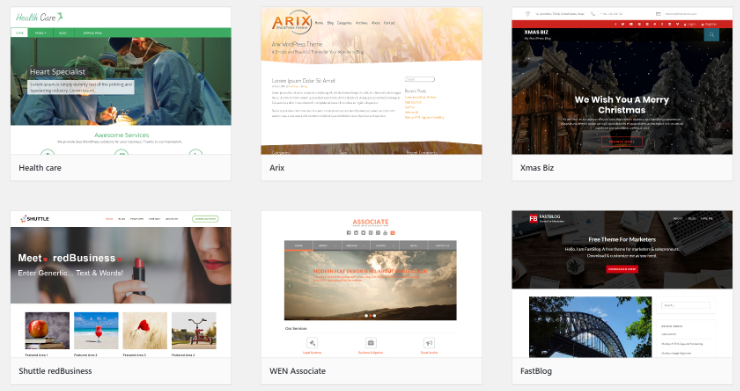
Most WordPress themes are highly customizable as well. Of course, you’re able to edit the theme text and add your own images and logo. But, many themes also allow you to change theme colors, layouts, fonts, and much more.
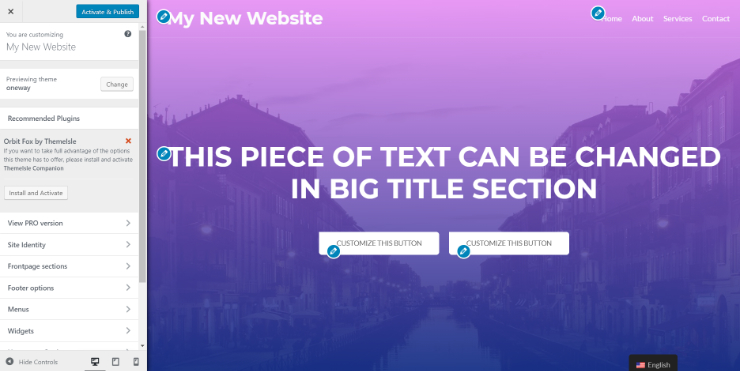
There are also many third-party premium WordPress themes available on the market. So, if you want a higher-quality theme that not everyone is able to get, you have that option as well.
Alternatively, you can use a drag and drop page builder to create a custom theme that’s all your own. We recommend using SeedProd. It comes with an easy-to-use visual page builder, over 100 templates, and ready-made blocks like optin forms, countdown timers, buttons, and much more.
2. Adding Content to Your WordPress Website
Next, you can easily add content to your WordPress website such as web pages and blog posts, using the WordPress post editor.
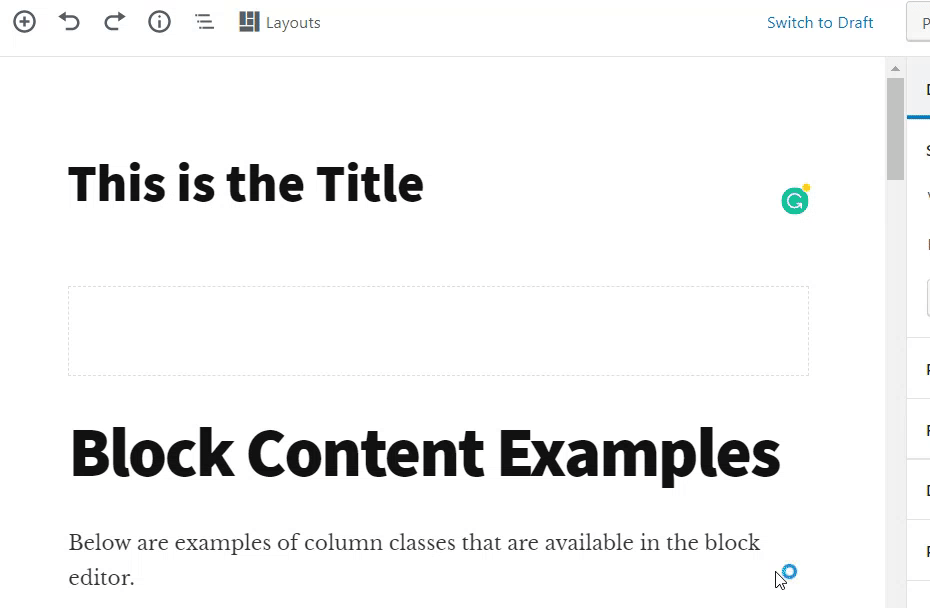
Whether you’re creating a page or a post, the WordPress editor looks the exact same. You can use the WordPress post and page editor, like in the image below, which is also known as Gutenberg editor or Block editor. Here, you add blocks of content elements to create a content layout.
This is what the new block editor looks like:
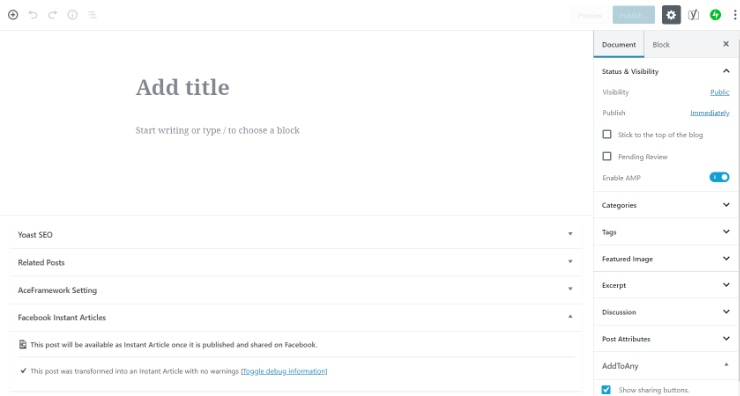
For example, you can add blocks for headings, paragraphs, images, lists, columns, buttons, and much more.
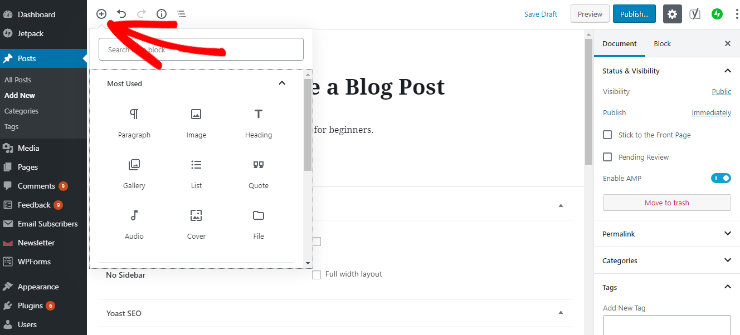
By default, Gutenberg starts you off with a heading and a paragraph block. But to add a new block, simply click on the add new block button. The add new block buttons show up in the top left hand corner of the editor, on the left side of a block, or below an existing block.

Each block also has its own toolbar and settings for formatting. For instance, with a paragraph block you have options such as bold, italic, text alignment, and more.

If you want to use the legacy WordPress classic editor instead of Gutenberg, check out this tutorial on how to disable Gutenberg and keep the classic editor in WordPress.
The legacy classic editor comes with 2 different editing screens: visual editor or the text editor which allows you to format your posts by adding HTML.
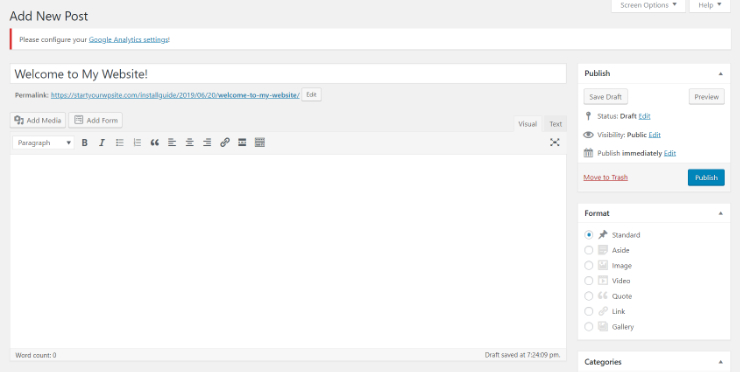
So, does WordPress have a drag and drop builder? As we mentioned previously, WordPress does not have a drag and drop builder. But adding images, video, bulleted lists, and other elements is as easy as 1 click of a button.
If you’d still prefer to use a drag and drop builder to create content, you can install a drag and drop page builder plugin such as SeedProd, Beaver Builder, Divi, or Elementor.
3. Using WordPress Plugins
Lastly, with WordPress plugins you can take your website to the next level. WordPress offers thousands of free plugins that you can use to add extra features to your website. And with over 55,000 plugins at the time of writing this article, almost anything you can think of will be available in the form of a plugin.
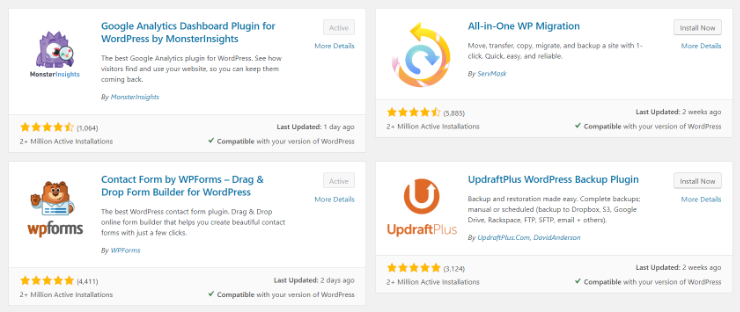
Plus, plugins are very easy to download and use. They’re just like apps that you add to your mobile phone. Simply download the plugin and voila, you’ve got something new for your website. Learn how to use them here: How to Install a WordPress Plugin – 3 Methods (Step by Step).
There are a number of WordPress plugins that are must-haves for any type of website, including:
- All in One SEO – Boost the online presence of your website and get more traffic.
- Thrive – Build your website with premade themes
- SeedProd – Create unique layouts and pages for your site.
- WPForms – Generate leads and connect with customers with a contact form on your website.
- OptinMonster – Grow your email list and generate more leads with popups.
- MonsterInsights – Track your website traffic and other analytics right from your WordPress dashboard.
- Shared Counts – Increase engagement and shares on social media.
- WP Rocket – Speed up your website.
- Duplicator – Backup your website.
WordPress also has plugins that allow you to transform a regular website into a powerful website. For example, if you want to create an online store, you can use an eCommerce plugin like WooCommerce, which is the most popular eCommerce solution for WordPress. Or you can create a membership site, where users have to pay monthly for access, using a plugin like MemberPress.
The sky’s the limit when it comes to WordPress plugins.
Is WordPress Free?
As we previously mentioned, WordPress is free to download and use. But, in order to build a website that’s live on the internet for other people to see, you do need to register a domain name and choose web hosting.
A domain name is your website’s address (URL) on the internet. For instance, our domain name is www.IsItWP.com. It’s what users type in their browsers to visit your website.
Web hosting is where your site lives on the internet. This space on the internet is where your website’s files and content are stored. When a user types in your website address in their browser, they’ll be taken to your website that you’ve set up with the web hosting provider.
Typically, a domain name costs around $14.99/year, and web hosting costs about $7.99/month. This can be a bit costly to some people, especially if you’re just starting out.
That’s why we recommend Bluehost. We’ve worked out an awesome Bluehost deal for IsItWP readers. You can get a free domain name and over 72% off on web hosting. That means you can make a website for as low as $1.99/month!

Plus, Bluehost is one the best WordPress hosting companies. They power over 2 million websites worldwide and it’s officially recommended by WordPress.org. Bluehost also offers 1-click WordPress installation, so it’s super easy to install and start building your website right away.
Click here to Claim this Exclusive Bluehost Offer »
Using WordPress and Bluehost is one of the most affordable ways to build a website.
WordPress Review: Is it the Best Website Builder For You?
WordPress is the most popular website builder on the market for a reason. With WordPress, you have complete control over your website, and you’re able to customize it in any way you choose.
Consider using WordPress if you want to build a professional-looking website without spending a lot of money or if you want to start a blog and make money online with it. If you just want to start a website for fun and not monetize it, you can choose a free website builder or blogging platform.
Also, consider ease of use before deciding. If you’re able to follow online tutorials to learn the basics, then go with WordPress. Once you get the hang of it, creating a website is simple. But, if you’re not interested in following tutorials and learning, it might be better for you to choose another website builder.
Get started here:
- How to Install WordPress – Beginner’s Guide
- How to Customize a WordPress Website
- How to Create a Custom WordPress Layout
We hope this WordPress review helped you decide whether WordPress is the best choice for you.

thank you hope its work
I have to point out my affection for your kindness giving support to people that absolutely need guidance on this one situation. Your personal commitment to passing the message across appears to be rather advantageous and have in most cases made employees just like me to achieve their aims. Your own useful tutorial implies a lot to me and especially to my mates. Many thanks; from all of us.
An excellent post, thank you!
“2. Adding Content to Your WordPress Website”… where is Gutenberg ? 🙂
Just updated the post. Thank you for stopping by 🙂